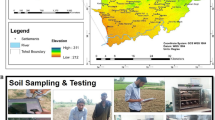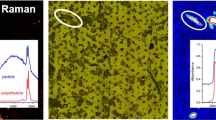Abstract
Traditional techniques and methods for evaluation and detection of soil samples are tedious, laborious, expensive, and time-consuming. In comparison, spectroscopic techniques have successfully overcome some of these disadvantages and can supplement or replace them. As soil is a complex media, it is difficult to assign specifically spectral features for physicochemical properties of soil. This study discusses the combined application of Attenuated Total Reflection Fourier Transform Infrared (ATR-FTIR), and Scanning Electron Microscopy coupled to EDX microprobe (SEM/EDX) methods for estimating soil physicochemical properties. For this purpose, 30 topsoil samples were measured according to standard methods of soil analysis. All spectra were collected in the mid-infrared (MIR) from 4000 to 650 cm-1. Chemometric methods were used in the analysis of multivariate data using the Quant2 package in OPUS 7 software and improved the prediction of soil properties using partial least squares regression (PLSR). The results showed that specific surface area (SSA MB-titration) had the best predictions for the soil properties in ATR-FTIR study with a RPD of 2.08, RMSE of 13.50 m2 g–1, and R2 of 0.77 (very good); followed by cation exchange capacity, organic carbon, SSA (BET), Al, clay, and Ca (good); saturation, sand, silt/clay, electrical conductivity, saturated hydraulic conductivity, K, silt, Fe, C, and Si (fair); O, Mg, pH, bulk density, porosity, total pore volume, and particle density (poor). Also, we found that SEM-EDX is able to perform a rapid simultaneous multielement analysis without any special soil sample preparation. Consequently, modern techniques, such as ATR-FTIR and SEM-EDX can be used for such studies according to the information needed and the time required for the sample preparation.

Similar content being viewed by others
REFERENCES
S. Romeiro Araújo, M. Söderström, J. Eriksson, C. Isendahl, P. Stenborg, and J. A. M. Demattê, “Determining soil properties in Amazonian Dark Earths by reflectance spectroscopy,” Geoderma 237, 308–317 (2015). https://doi.org/10.1016/j.geoderma.2014.09.014
V. Bellon-Maurel and A. McBratney, “Near-infrared (NIR) and mid-infrared (MIR) spectroscopic techniques for assessing the amount of carbon stocks in soils—critical review and research perspectives,” Soil. Biol. Biochem. 43, 1398–1410 (2011). https://doi.org/10.1016/j.soilbio.2011.02.019
M. R. Carter and E. G. Gregorich, Soil Sampling and Methods of Analysis, 2nd ed. (CRC Press, Boca Raton, 2008).
M. Choel, K. Deboudt, and P. Flament, “Development of time-resolved description of aerosol properties at the particle scale during an episode of industrial pollution plume,” Water, Air Soil Pollut. 209, 93–107 (2010). https://doi.org/10.1007/s11270-009-0183-9
M. Choel, K. Deboudt, j Osan, P. Flament, and R. van Grieken, “Quantitative determination of low-Z elements in single atmospheric particles on Boron substrates by automated scanning electron microscopy-energy-dispersive X-ray spectrometry,” Anal. Chem. 77, 5686–5692 (2005). https://doi.org/10.1021/ac050739x
I. G. Chong and C. H. Jun, “Performance of some variable selection methods when multicollinearity is present,” Chemom. Intell. Lab. Syst. 78, 103–112 (2005).https://doi.org/10.1016/j.chemolab.2004.12.011
J. H. Dane and C. G. Topp, Methods of Soil Analysis, Part 4: Physical Methods, SSSA Book Series 5.4 (Soil Science Society of America, Madison, WI, 2002).
H. G. M. Edwards, E. M. Newton, and J. Russ, “Raman spectroscopic analysis of pigments and substrata in prehistoric rock art,” J. Mol. Struct. 550, 245–256 (2000). https://doi.org/10.1016/S0022-2860(00)00389-6
A. P. Fernández-Getino, Z. Hernández, A. Piedra Buena, and G. Almendros, “Exploratory analysis of the structural variability of forest soil humic acids based on multivariate processing of infrared spectral data,” Eur. J. Soil Sci. 64, 66–79 (2013). https://doi.org/10.1111/ejss.12016
K. G. Giniyatullin, A. A. Shinkarev, G. A. Krinari, T. Z. Lygina, A. M. Gubaidullina, A.G. Kornilova, and L. V. Mel’nikov, “Irreversible fixation of organic components in labile interspaces as a mechanism for the chemical stabilization of clay-organic structures,” Eurasian Soil Sci. 45, 1068–1080 (2012). https://doi.org/10.1134/S1064229312050043
K. G. Giniyatullin, A. A. Shinkarev, G. A. Krinari, T. Z. Lygina, A. M. Gubaidullina, A.G. Kornilova, and L. V. Mel’nikov, “Binding of organic matter into an oxidation-resistant form during the interaction of clay minerals with plant residues,” Eurasian Soil Sci. 43, 1159–1173 (2010). https://doi.org/10.1134/S1064229310100091
A. Gobrecht, J. M. Roger, and V. Bellon-Maurel, “Major issues of diffuse reflectance NIR spectroscopy in the specific context of soil carbon content estimation: a review,” in Advances in Agronomy, Ed. by D. L. Sparks (Academic, London, 2014), Vol. 123, pp. 145–175. https://doi.org/10.1016/B978-0-12-420225-2.00004-2
N. Goienaga, A. Sarmiento, M. Olivares, J. Antonio Carrero, L. A. Fernández, and J. M. Madariaga, “Emerging application of a structural and chemical analyzer for the complete characterization of metal-rich particulate matter,” Anal. Chem. 85, 7173–7181 (2013). https://doi.org/10.1021/ac400878y
L. Gomez-Nubla, J. Aramendia, A. Alonso-Olazabal, S. Fdez-Ortiz de Vallejuelo, K. Castro, L. A. Ortega, and J. M. Madariaga, “Darwin impact glass study by Raman spectroscopy in combination with other spectroscopic techniques,” J. Raman Spectrosc. 46 (10), 913–919 (2015). https://doi.org/10.1002/jrs.4700
A. Gredilla, S. F. de Vallejuelo, N. Elejoste, A. de Diego, and J. M. Madariaga, “Non-destructive spectroscopy combined with chemometrics as a tool for Green chemical analysis of environmental samples,” Trends Anal. Chem. 76, 30–39 (2016). https://doi.org/10.1016/j.trac.2015.11.011
S. Hapca, P. C. Baveye, C. Wilson, R. M. Lark, and W. Otten, “Three-dimensional mapping of soil chemical characteristics at micrometric scale by combining 2D SEM-EDX data and 3D X-Ray CT images,” PLoS One 10 (9), e0137205 (2015).
A. Horta, B. Malone, U. Stockmann, B. Minasny, T. F. A. Bishop, and L. Pozza, “Potential of integrated field spectroscopy and spatial analysis for enhanced assessment of soil contamination: a prospective review,” Geoderma 241, 180–209 (2015). https://doi.org/10.1016/j.geoderma.2014.11.024
P. M. Jardine, J. C. Parker, and M. A. Stewart, Decreasing Toxic Metal Bioavailability with Novel Soil Amendment Strategies: Final Report CU-1350 (Strategic Environmental Research and Development Program, Alexandria, VA, 2007).
R. A. Johnson and D. W. Wichern, Applied Multivariate Statistical Analysis, 6th ed. (Pearson Education, New Jersey, NJ, 2007).
A. Kiros, V. Lazic, G. E. Gigante, and A. V. Gholap, “Analysis of rock samples collected from rock hewn churches of Lalibela, Ethiopia using laser-induced breakdown spectroscopy,” J. Archaeol. Sci. 40, 2570–2578 (2013). https://doi.org/10.1016/j.jas.2013.01.028
A. D. Lorna and S. Hillier, “Measurement of soil characteristics for forensic applications,” Surf. Interface Anal. 42, 363–377 (2010). https://doi.org/10.1002/sia.3315
J. Moros, R. J. Cassella, M. C. Barciela-Alonso, A. Moreda-Piñeiro, P. Herbello-Hermelo, P. Bermejo-Barrera, and M. De la Guardia, “Estuarine sediment quality assessment by Fourier-transform infrared spectroscopy,” Vib. Spectrosc. 53, 204–213 (2010). https://doi.org/10.1016/j.vibspec.2010.03.001
L. W. Petersen, P. Moldrup, O. H. Jacobsen, and D. E. Rolston, “Relations between specific surface area and soil physical and chemical properties,” Soil Sci. 161, 9–21 (1996).
E. F. M. Pinheiro, M. B. Ceddia, C. M. Clingensmith, S. Grunwald, and G. M. Vasques, “Prediction of soil physical and chemical properties by visible and near-infrared diffuse reflectance spectroscopy in the central Amazon,” Remote Sens. 9, 1–22 (2017). https://doi.org/10.3390/rs9040293
R. Ravisankar, G. Senthilkumar, S. Kiruba, A. Chandrasekaran, and P. P. Jebakumar, “Mineral analysis of coastal sediment samples of Tuna, Gujarat,” Indian J. Sci. Technol. 3, 858–862 (2010).
J. B. Reeves, “Near-versus mid-infrared diffuse reflectance spectroscopy for soil analysis emphasizing carbon and laboratory versus on-site analysis: where are we and what needs to be done?” Geoderma 158, 3–14 (2010). https://doi.org/10.1016/j.geoderma.2009.04.005
J. B. Reeves, R. F. Follett, G. W. McCarthy, and J. M. Kimble, “Can near or mid-infrared diffuse reflectance spectroscopy be used to determine soil carbon pools?” Commun. Soil. Sci. Plant Anal. 37, 2307–2325 (2006). https://doi.org/10.1080/00103620600819461
A. Rinnan, F. V. Berg, and S. B. Engelsen, “Review of the most common preprocessing techniques for near-infrared spectra,” Trends Anal. Chem. 28, 1201–1222 (2009). https://doi.org/10.1016/j.trac.2009.07.007
B. J. Saikia and G. Parthasarathy, “Fourier transform infrared spectroscopic characterization of kaolinite from Assam and Meghalaya, Northeastern India,” J. Modern Phys. 1, 206–210 (2010). https://doi.org/10.4236/jmp.2010.14031
R. Salzer and H. W. Siesler, Infrared and Raman Spectroscopic Imaging (Wiley, Weinheim, 2014).
R. Signorell and J. P. Reid, Fundamental and Application in Aerosols Spectroscopy (CRC Press, Boca Raton, 2017). pp. 218–250.
F. S. Terra, J. A. M. Dematte, and R. A. Viscarra-Rossel, “Spectral libraries for quantitative analysis of tropical Brazilian soils: comparing VIS-NIR and MIR reflectance data,” Geoderma 255, 81–93 (2015). https://doi.org/10.1016/j.geoderma.2015.04.017
R. A. Viscarra Rossel and T. Behrens, “Using data mining to model and interpret soil diffuse reflectance spectra,” Geoderma 158, 46–54 (2010). https://doi.org/10.1016/j.geoderma.2009.12.025
R. A. Viscarra Rossel and R. M. Lark, Improved analysis and modeling of soil diffuse reflectance spectra using wavelets,” Eur. J. Soil Sci. 60, 453–464 (2009). https://doi.org/10.1111/j.1365-2389.2009.01121
R. A. Viscarra Rossel, R. N. McGlynn, and A. B. McBratney, “Determining the composition of mineral-organic mixes using UV–vis–NIR diffuse reflectance spectroscopy,” Geoderma 137, 70–82 (2006). https://doi.org/10.1016/j.geoderma.2006.07.004
B. Woods, C. Lennard, K. P. Kirkbride, and J. Robertson, “Soil examination for a forensic trace evidence laboratory—Part 1: Spectroscopic techniques,” Forensic Sci. Int. 245, 187–192 (2014). https://doi.org/10.1016/j.forsciint.2014.08.009
Y. Yukselen and A. Kaya, “Comparison of methods for determining specific surface area of soils,” J. Geotech. Geoenviron. Eng. 132, 931–936 (2006).
Funding
This study was funded by Shahid Beheshti University, Tehran.
Author information
Authors and Affiliations
Corresponding author
Ethics declarations
The authors declare that they have no conflict of interest.
Rights and permissions
About this article
Cite this article
Aghamir, F., Hamidi, S.M., Tehranchi, M.M. et al. Combined Application of Imaging Methods for Estimating Soil Physicochemical Properties. Eurasian Soil Sc. 52, 926–934 (2019). https://doi.org/10.1134/S1064229319080027
Received:
Revised:
Accepted:
Published:
Issue Date:
DOI: https://doi.org/10.1134/S1064229319080027




